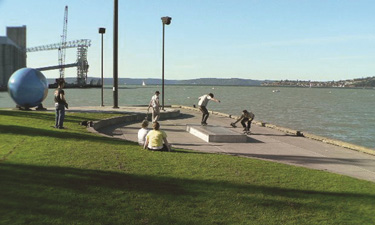 “We need a skatepark!”
“We need a skatepark!”
You’ve likely heard this from your community lately. As skateboarding youth turn to activism to meet their needs, parks departments everywhere are faced with a growing vocal constituency. Due to challenging budgets, parks planners have had to be increasingly creative in fulfilling their constituents’ needs. Thanks to innovative funding schemes and passionate park staffs, skateparks are being built at an unprecedented rate. Even those unprepared to pursue a full-size neighborhood skatepark are able to produce tangible solutions for their growing needs.
Skateparks come in all shapes and sizes, and skatepark development often takes years of planning and fundraising before ground-breaking. Considering the time it takes to create a regional skatepark that will service the entire community, some parks departments have addressed the immediate need for skateboarding attractions by creating smaller “skate spots” in appropriate areas and away from traffic.
Skate spots replicate forms found in your community that skaters are currently entertaining themselves on. Most of the design considerations for creating a skate spot can be found around your town. The fact is that your town already has real skate spots; they’re just inappropriate places to skate. Skate spots merely replicate these types of attractions, but are located in areas where recreation is desired. You merely need to find those tell-tale signs of skateboarding activity, such as a black waxy ledge, to see what will attract your skateboarding youth. When your skate spot is better than the inappropriate street spot, you will mitigate skateboarding where it’s not desired.
Skate spots all have certain characteristics that make them appealing to skaters and parks planners. The key characteristic is that they are small. A typical skate spot is a single, simple, above-ground, concrete structure requiring approximately 1,500 square feet of space (including flat space to approach and roll away from the element). The spot will support up to five skaters, each taking turns.
Nearly all skate spots are designed to appeal specifically to a certain type of skater. The spots are geometric, with their leading edges protected with steel, stone, or concrete. Most are rectangular pads, known as manual pads, or ledges that resemble seating walls. Skate spots seldom feature the curving faces (transitions or bowls) that feature prominently in traditional skateparks.
Due to the small physical and perceptional impact on the space, most of the hefty considerations that go into a larger skatepark can be avoided. For example, skate spots don’t require fences because they’re not exclusive structures and it simply wouldn’t be appropriate to install a fence around a “skateable bench.” A skate spot might also serve as a seating wall, planter, public art, or some other unobtrusive form. The best skate spots provide practical uses in addition to skateboarding.
They are typically located in existing public parks and can leverage existing park amenities. Often, skate spots are built next to existing walkways as a bulb-out. This allows the skateboarders to share portions of the walkway as an approach and exit path. Because skateboarders using the skate spot are travelling at such slow speeds, potential collisions with pedestrians are minimized.
Another appeal of the skate spot is that the small numbers of skateboarders that can use them concurrently reduces community fears that sometimes arise with larger skateboarding facilities. Neighbors to the site are much less likely to be alarmed by the inclusion of a few local skateboarding youth than what they imagine will be hundreds of boisterous youth that will materialize at a larger facility.
Communities that are particularly risk-averse may struggle to reconcile this degree of skateboarding acceptance and inclusion. At the skate spot, skaters will be integrated with pedestrians of all types. Local helmet ordinances will be difficult to enforce at the spot, as it lacks the clear delineation and border of a traditional skatepark. That said, communities that have employed skate spots as a way of augmenting their traditional skateparks have found them to be wildly successful. That’s not to say that they don’t have their risks—people may mistake the skate spot as a “non-skating” structure and be irritated by the activity they see there. However, concerns like this subside as people become familiar with the sport and realize that skateboarding is intended there.
As a final consideration, the cost of skate spots make them easily affordable to small community groups through grassroots fundraising events and community grants. Your skateboarding community should be happy to inform the design, while spatial concerns and the bid process can be managed by the parks department.
Skate spots can be an expedient, sustainable part of your long-term skatepark master plan.
Peter Whitley is Programs Director at the Tony Hawk Foundation, a nonprofit organization dedicated to assisting communities pursuing free, quality, public skateparks.

